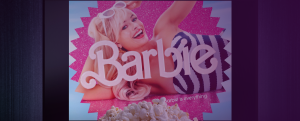On the 21st of July, the pop culture event of the year will take place: Barbie will be released in cinemas. Apart from the massive marketing campaign that – I’m pretty sure – at one point will be studied in schools, the cinematic event of the year is also teaching us a thing or two about why our industry needs to be open minded, especially when it comes to the audience they might want to address.
The traditional demographic for Barbie was of course pre-teenager girls with a passion for sparkly dresses and perfectly brushed hair. And no doubt this would have been the standard client brief before this year’s earthquake. Now Barbie is everywhere – even my grandma knew about the film (and seems lowkey excited about it?).
Everyone is talking about it, from working adults to the Twitterverse, from politicians to the LGBTQ+ community. Barbie has become a worldwide and intergenerational event.
Then add to the equation an unlikely mash-up, caused by another – some say polar opposite – film sharing the same release date. Enter “Barbenheimer” on Google – a cultural phenomenon with 14+ million Google results and a dedicated Wikipedia page, blending Barbie with the story of the inventor of the nuclear bomb. Before 2023, any overlap between the two films would have been unthinkable. But now, these two distinct target audiences have come together on t-shirt prints and ultimately both may benefit, in a weird turn of events, from an unlikely joint marketing campaign.
Barbie emerged as a brand in 1959. Kids obviously now have many more options for play outside of plastic dolls – but regardless, I have never seen a bigger buzz online for a movie release – Barbie is EVERYWHERE.
The key takeaway here is that relying on the idea of “someone should like something” just because they fit into a certain stereotype may be out of date. And Greta Gerwig clearly understood that and made it the film’s key selling point – after all the key line in the film’s trailer is “If you like Barbie, this film is for you. If you don’t like Barbie, this film is also for you”.
In media terms, if Warner Bros had decided to only speak to Barbie’s staple audience, they would have missed out on much of the audience they now find queuing up to watch. They might even have negated an entire cultural event… because that is what they have ultimately created.
This is a philosophy close to Nano’s heart: we don’t really like stereotypes – we’ve even made it one of our core principles when building our latest offering, Intent Personas.
Demographic targeting might have served its purpose in the past, but with all that our industry has in store for us in the next two years (Google’s cookie Adpocalypse, Apple’s rapid improvement in privacy standards, etc.) we as marketers need to finally come to terms with the idea that it’s time to move forward.
If there’s one message to take away from this article: it’s 2023, and things are changing. Things have changed already, really (Barbie says so!) – and it looks like we might be slowly catching up.







